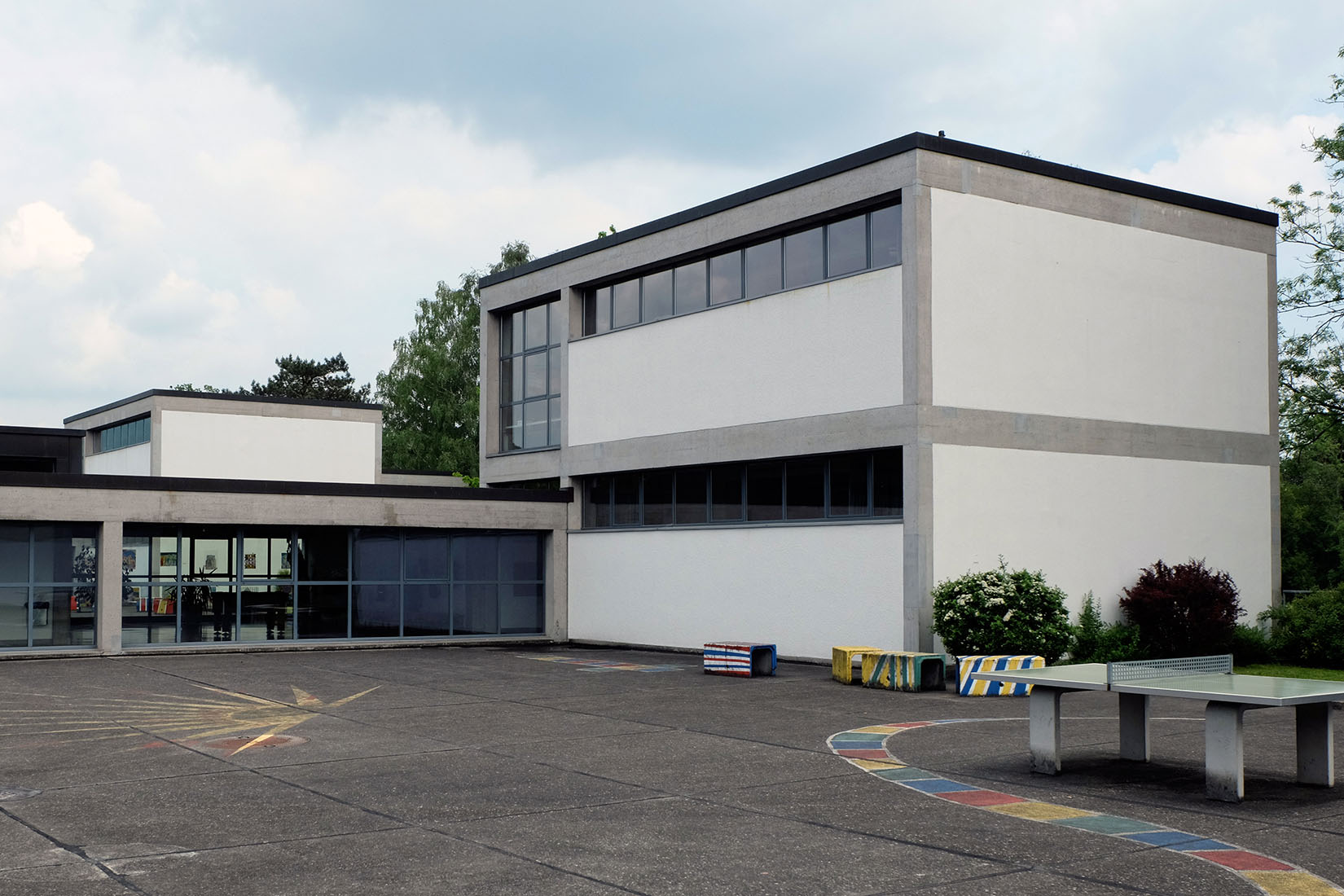 |
 |
 |
 |

School Building Scheibenschachen
Bündtenweg, Aarau
1961 - 1963
In the residential district Scheibenschachen in the city of Aarau was built a new school building by the Architects Barth & Zaugg in the years 1961-1963.
The school is for students of first to sixth grade. The realization of the building was originally scheduled in two phases. But due to the great lack of space,
the whole complex was built in one stage. The school site is located on the northern banks of the river Aare, separated from the water only by
a walkway and a low embankment. Above the riverside the silhouette of the historic town of Aarau is visible. This unique location
has strongly influenced the design of the school building. The design of the ensemble is consistently based on a cubic grid of 1.03 m.
The construction principle consists of a reinforced concrete skeleton with so-called Durisol-infills. For the exterior walls stones of 20 cm thickness were used,
while the inner walls were made of stones of 15 cm thicknes. The sash bars of the windows are made of steel profiles. Unfortunately, these had to be partially
retrofitted by closed parapet elements. The used sandwich construction allows any time the replacement with panes of glass.
Three narrow classroom wings were arranged along the waterfront. Each contains four classrooms, a hall with wardrobe and the toilet facilities as well as an open-air school.
With one exception, the classrooms are equipped with an additional niche intended for crafting. Between the classroom wings are located the school court and playground areas.
These were raised 1.90 m above the existing terrain and thereby also receive an intense relationship with the river landscape. At the same time, this measure allowed
to avoid the need of expensive groundwater insulations. Two wide ramps lead to the level of the school courts and the entrances. An approximately 120 m long
open gallery connects the classroom wings with the tract of the general spaces. This general wing appears in the form of a low-rise building in the southwest of the site,
and includes the spaces which are also needed for the evening operation: the music hall with gallery, two workshops, two handicraft rooms, teacher and rector rooms and the gym.
The gymnastic courts are located between the school in the south and the protestant manse and parish hall in the north. Fortunately, both buildings were also designed by
the architects of the school building. Thus arose a uniform complex with buildings from several stages within one rectangular block.
The school is for students of first to sixth grade. The realization of the building was originally scheduled in two phases. But due to the great lack of space,
the whole complex was built in one stage. The school site is located on the northern banks of the river Aare, separated from the water only by
a walkway and a low embankment. Above the riverside the silhouette of the historic town of Aarau is visible. This unique location
has strongly influenced the design of the school building. The design of the ensemble is consistently based on a cubic grid of 1.03 m.
The construction principle consists of a reinforced concrete skeleton with so-called Durisol-infills. For the exterior walls stones of 20 cm thickness were used,
while the inner walls were made of stones of 15 cm thicknes. The sash bars of the windows are made of steel profiles. Unfortunately, these had to be partially
retrofitted by closed parapet elements. The used sandwich construction allows any time the replacement with panes of glass.
Three narrow classroom wings were arranged along the waterfront. Each contains four classrooms, a hall with wardrobe and the toilet facilities as well as an open-air school.
With one exception, the classrooms are equipped with an additional niche intended for crafting. Between the classroom wings are located the school court and playground areas.
These were raised 1.90 m above the existing terrain and thereby also receive an intense relationship with the river landscape. At the same time, this measure allowed
to avoid the need of expensive groundwater insulations. Two wide ramps lead to the level of the school courts and the entrances. An approximately 120 m long
open gallery connects the classroom wings with the tract of the general spaces. This general wing appears in the form of a low-rise building in the southwest of the site,
and includes the spaces which are also needed for the evening operation: the music hall with gallery, two workshops, two handicraft rooms, teacher and rector rooms and the gym.
The gymnastic courts are located between the school in the south and the protestant manse and parish hall in the north. Fortunately, both buildings were also designed by
the architects of the school building. Thus arose a uniform complex with buildings from several stages within one rectangular block.
